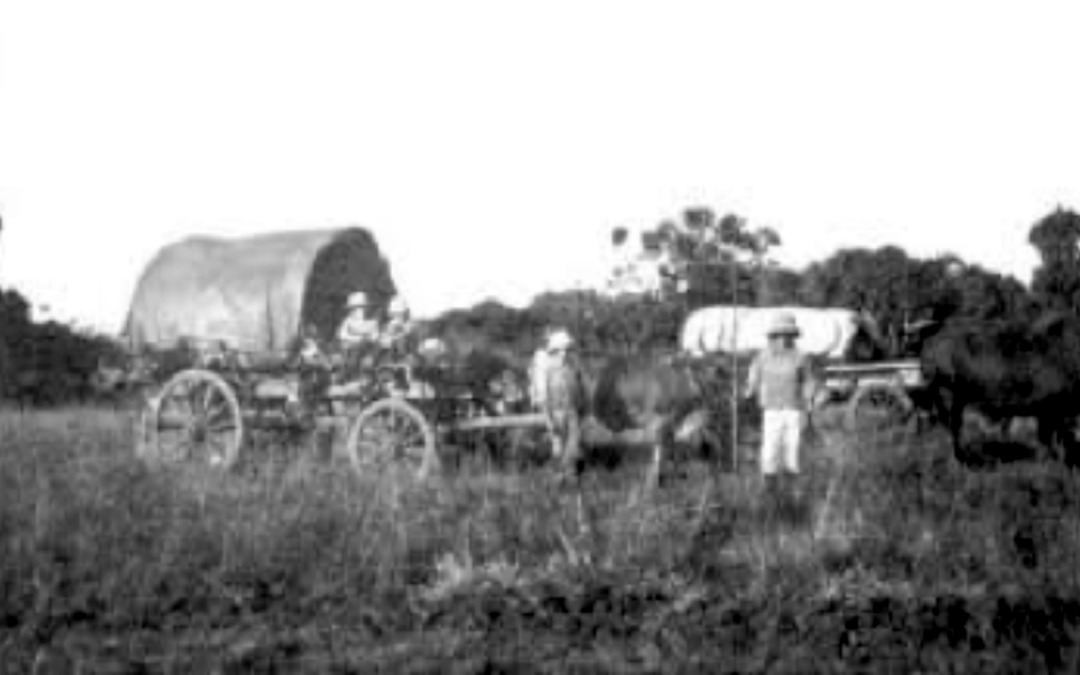Early White Settlers from Britain in Trans-Nzoia
Mrs Gladys Hoey reached the plateau in 1913, arriving with her father in an ox wagon. Her future husband, Cecil, later a breeder of racehorses, had reached the Nzoia river in 1904 when on a hunting expedition. He felled trees to make a river crossing – known thereafter as Hoey’s Bridge (now Moi’s Bridge). Many Boers from South Africa had also made their farms on the plateau, and it was not until after the First World War that settlers from the British Isles arrived in any number. How did these travellers reach Trans-Nzoia? For the early Boers, it was a hazardous journey. At the beginning of 1907 Frans Arnoldi and others left Nakuru to travel up the western wall of the Rift Valley by ox wagon, and then on to the plateau where they stayed with the van Breda brothers. The journey took two months. The Van Rensburg trek up the western wall of the escarpment began in August 1908. The wagons crossed the Rongai and Molo rivers, traversed the forests and bamboo beyond Eldama Ravine and eventually forded the Sosiani river. Cecil Hoey, camped at Lake Sergoit on a hunting safari, watched the wagons through his binoculars. The Van Rensburg trek rested up on the farm of John de Waal at the end of October 1908. Then the Commissioner of Lands, Colonel J.A.L. Montgomery, and Piet van Breda (in his capacity as a land surveyor), allocated them land on the plateau and each family began farming.
There is a good description of the route a few years later, by Margaret Pharazyn, who travelled to the area in 1920. The starting point was Londiani, whither trekkers arrived by train. Thereafter the journey was undertaken by 16-oxen wagons and scotch carts. The first hill proved too much for the oxen, so all 32 had to be attached to each wagon or cart. Only three miles were achieved on the first day, but afterwards the average was six miles a day. Every night tents were pitched and oxen outspanned, as near as possible to water. Employees were sent on ahead to find water, and the oxen were also outspanned and watered at midday. Eventually, after three weeks, the small settlement of Eldoret was reached. As its Pioneer Hotel was deemed unsuitable for ladies, tents were pitched behind it. The travellers restocked and set off again.
Finding their allotted farm was very difficult. After the First World War the British Government had worked with a blue-print of the area, drawing boundaries for farms to be allocated to new settlers. Iron beacons three feet high had been placed in the ground, but these were almost impossible to see in grass six feet high. Eventually the correct location was found and a dwelling was built. The walls were made of wet clay rolled into ostrich-egg-sized balls dried hard in the sun and stuck together with wet mud, and the roof was made of grass supported on poles placed outside the walls. There was a wide gap between walls and roof allowing all manner of small animals and insects to invade. The floor was of mud and there was no door or windows – just gaps. The house was heated on cold nights by charcoal burned in debes (tin petrol cans). The kitchen was a grass shelter and the oven a hollowed-out anthill.
Kitale did not exist, and Eldoret was 44 miles away. The nearest railhead was Londiani and that was 100 miles away. At Eldoret a trotting oxcart service was run by the local auctioneer. This was a covered van pulled by six oxen, with a board placed across it for passengers to sit on. This bone-shaking vehicle changed its horses every six miles until Londiani and the railway were attained.
The first buildings to appear in what became Kitale were built in the early 1920s. These were a house for the District Commissioner and a Police Station. They sat in the middle of nowhere surrounded by bush, but with the arrival of the railway in Eldoret in 1923, the place began to develop. Three years later a branch line was built to Kitale. As Margaret Pharazyn commented: ‘With the coming of the railway the wild and woollie days of the Trans Nzoia came to an end. We were fast becoming civilised with all the controls, red tape, licences, restraints and constraints which civilisation imposes on the community to curb their individuality and dictate a policy unwished for by those who had been happy shaping their own ends along their own lines.’
Next month I shall talk about the schools set up in the area and the tension this caused between the British and South Africans.


Recent Comments